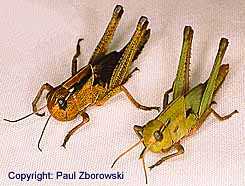Nymph description 3 of 15

Distribution

Nymph Description: Locusta has different phases with the solitary phase the most commonly encountered:
Solitary phase: Colour from brown to green. In profile the thorax is slightly domed above the head and crested. A dark stripe starts at the antenna, goes up through the eye at a 45 degree angle and becomes horizontal before fading into the thorax, which has a small but prominent dark spot. Rear femur has two oblique darker bands.
Gregarious phase: Colour is red to orange with very contrasting darker to almost black markings. In profile the thorax is not domed but saddle-shaped and even lower than the head. A dark stripe starts at the antennae, goes up through the eye at a 45 degree angle and becomes horizontal as it continues across the thorax. In later instars this becomes a prominent stripe along the entire body.
Confusion with Australian plague locust: This is a large species with later instars bigger than plague locust adults.
Confusion with yellow winged locust: Similar size and domed appearance (compare photos).Unique features: The combination of large size, only slightly domed thorax, an eye stripe which becomes horizontal at the back of the eye, and a hairy 'chest' or downy layer on underside of thorax.
Further information on this species: Description of adult, More images, Distribution, Biology
